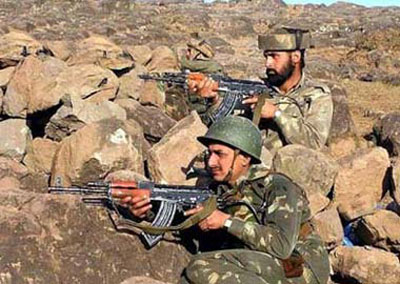 Last
Last Saturday, Air Chief Marshal NAK Browne used strong words in relation to Pakistan’s violation of the Line of Control (LoC). If Pakistan did not behave, “we may have to look at some other options for compliance.” He gave the impression that the armed forces had taken the brutal killing of the two soldiers to heart and would deal tough with a rogue neighbour.
Two days later, Indian Army Chief General Bikram Singh punctured that assumption and clarified that the “other options” that the Air Chief Marshall talked about related to diplomatic and economic levers. He managed to turn his air force counterpart from hawk to dove when talking about Pakistan’s action of beheading a dead Indian soldier.
It is tough to guess why General Singh chose to play down the tough message from the air force chief. But the army chief’s interpretation is obviously in line with the soft stance adopted by the civilian political heads in the establishment who have been at pains to emphasise that the issue should not be escalated.
But even General Singh didn’t begin with a soft line. In his opening statement, he said “we reserve the right to retaliate at a time and place of our choosing”. But when it came to detail, he elaborated on the localised nature of the operation, which would be dealt with at the tactical level. The implicit meaning was that the time and place of action would not be outside the current zone of ceasefire violation.
He maintained that the morale of the forces serving on the LoC was of supreme importance. “I expect all my commanders to be aggressive and offensive in (response to) provocation. The commanders have been directed to respond to provocation. We shall not be passive to fire. (But) the response will always be measured and to effect.”
But what raised eyebrows was the Army Chief’s admission that Lance Naik Hemraj Singh’s beheading was not the first such incident, and at least two similar incidents had take place before – one in 2012 and another in 2011. The incidents were underplayed then and only some unconfirmed reports surfaced. The families of the martyrs were not allowed to see the mutilated bodies, like in the case of Hemraj Singh. To a pointed query on how many soldiers had been beheaded on those two occasions, the army headquarters did not want to reveal it publicly at today’s briefing.
The big question is this: had it not been for the media ruckus and consequent popular outrage, would the political establishment have let the sacrifice of Lance Naik Hemraj Singh and Sudhakar Singh pass away quietly and proceed with the peace process as though nothing else mattered? Prime Minister Manmohan Singh has invested too much of his own personal capital in the peace process and would not like it to be derailed in the closing months of UPA-2.
The sustained media focus and fast by Hemraj Singh’s family and kin demanding that the government should pressure Pakistan to get his severed head back has forced the government to respond. It’s no different from how the government initially responded to the Delhi gangrape case.
General Bikram Singh’s media interaction allowed him to vent his own feelings. He wanted the government to do more, and “raise the (issue) at the highest level” at various forums.
“This is unacceptable and unpardonable. We lodged a very strong protest with our government, and through our government to them, then at DGMO meeting and today at the flag meeting”, he said.
The statistics on ceasefire violations by Pakistan, ostensibly to give cover to infiltrators, have been alarming. While such violations took place as recently as yesterday night, last year there were 117 instances, on an average every third day, whereas in 2011 the average was every six days.
Being a democracy and a responsible nation, it seems the onus is more on India to maintain the ceasefire agreement of November 2003. Pakistan, where the military holds some power independent of the civilian authority, can apparently violate it at will and get away with it. The Army Chief, however, still sees some merit in the ceasefire agreement. According to him the violations are in certain segments like Uri, Krishnaghari, Poonch and some other areas, not on the whole of the LoC or international border. These take place because of local dynamics. He believes that “the ceasefire to a large extent is holding”.
The current bout of firing and mutilation of Indian soldiers was probably the work of Pakistani SSG commandos and army regulars because the Indian army had effectively blocked the shortest infiltration route at Churunda in the Uri sector, the Army Chief suggested.
 Last Saturday, Air Chief Marshal NAK Browne used strong words in relation to Pakistan’s violation of the Line of Control (LoC). If Pakistan did not behave, “we may have to look at some other options for compliance.” He gave the impression that the armed forces had taken the brutal killing of the two soldiers to heart and would deal tough with a rogue neighbour.
Last Saturday, Air Chief Marshal NAK Browne used strong words in relation to Pakistan’s violation of the Line of Control (LoC). If Pakistan did not behave, “we may have to look at some other options for compliance.” He gave the impression that the armed forces had taken the brutal killing of the two soldiers to heart and would deal tough with a rogue neighbour.